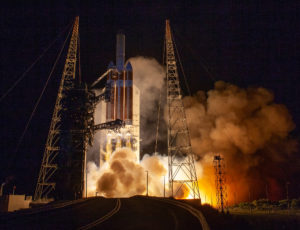At 6:07 a.m. EDT on Aug. 20, 2018, NASA’s Parker Solar Probe successfully completed its first trajectory correction maneuver (known as TCM-1), achieving a near-perfect firing of its propulsion system and putting the spacecraft on course to “touch” the Sun. This maneuver sets up the orbital geometry that will allow Parker Solar Probe to come within about 3.83 million miles (8.86 solar radii) of the Sun’s surface on its closest approach in 2024.
Following launch at 3:31 a.m. EDT on Aug. 12, the spacecraft control team at the Johns Hopkins Applied Physics Laboratory, or APL, in Laurel, Maryland, analyzed Parker Solar Probe’s position and quickly developed a re-optimized trajectory to place it in the best path for the seven Venus gravity assist maneuvers and 24 solar orbits that the mission will make. Re-assessing a spacecraft’s trajectory after launch is a normal step, as the mission team is then able to accurately track the spacecraft’s actual speed, direction and position to create a more precise trajectory plan.

Spacecraft controllers at the mission operation center initiated the two-part TCM-1 beginning at 6:00 a.m. EDT on Aug. 19 with a 44-second burn of the engines. The majority of the engine firing, which lasted just over seven minutes, began at 6:00 a.m. EDT on Aug. 20.
“TCM-1 is one of the critical events of the mission and a major mission milestone,” said Parker Solar Probe mission design and navigation manager Yanping Guo, from APL. “In the future, we only need to fine-tune the trajectory periodically, and no major adjustments or large maneuvers will be required unless something unusual happens. In short: We are on our way to touch the Sun!”
“The team completely nailed this maneuver,” said APL’s Andy Driesman, Parker Solar Probe project manager. “Execution of the burn was exceptional, measuring at less than 0.2 percent magnitude error—which translates to a 0.3 standard deviation, or sigma, from optimal. We had defined success for TCM-1 as up to 3 sigma, which really illustrates how phenomenally this was executed.”
As of 12:00 p.m. EDT on August 20, Parker Solar Probe was 5.5 million miles from Earth, travelling at 39,500 miles per hour.
By Geoff Brown
Johns Hopkins University Applied Physics Lab
